1.2: Understanding the Digital Consumer
- Page ID
- 89451
- Understand what are personas, journeys, and maps, how to calculate customer lifetime value, and why this is important.
In this chapter, we discuss how digitalization is transforming the journey of consumers. To better understand how to do marketing online, we also cover basic marketing tools (i.e., persona and consumer journey) to help us create digital marketing campaigns. We conclude the section by discussing journey maps.
Understanding Consumers Through Personas
There exist two grand approaches to conducting marketing: mass marketing (i.e., an undifferentiated approach where products are simply sold to the masses) or targeted marketing (click here for more information on these approaches). In the latter approach, firms practice segmentation and tailor marketing communications and products to segments. The digital ecosystem makes it quite easy to address segments, even segments of one. Although it is possible to practice mass marketing online, many processes unique to digital marketing, such as web analytics, A/B testing, or the use of online targeting platform, work best when firms have defined segments. For this reason, we are going to emphasize a targeted approach in this course.
To practice targeted marketing, firms use segmentation to create groups of consumers that are homogeneous (i.e., they have similar characteristics) but are heterogeneous from the rest of the population (i.e., they are different from the rest of people based on their shared characteristics).
A useful tool to help create and represent segments are personas. A persona is a semi-fictional, generalized representation of a customer segment. They help you better understand your customers (and prospective customers), and make it easier for you to tailor content to the specific needs, behaviors, and concerns of different segments.

Personas are important because they help you understand who your ideal consumers, what their characteristics are, and how to talk to them. The needs, desires, and problems of your personas (or segments, more generally) should be the starting point of any marketing strategy. As a reminder from chapter 1, our goal as marketers is to create value, and in digital marketing campaigns, we create value by representing the customer. The only way possible to do so is to understand how this customer is and what they need. Personas can assist a wide variety of marketing activities, from creating campaigns and ads to guiding product and service development to helping with customer support. We will see how shortly.
Firms develop personas the same way they develop segment: through market research and the use of internal data. Firms typically segment consumers based on their behaviors (which are also now trackable online!), demographics, lifestyles, or psychographics (see the table below for a brief summary).
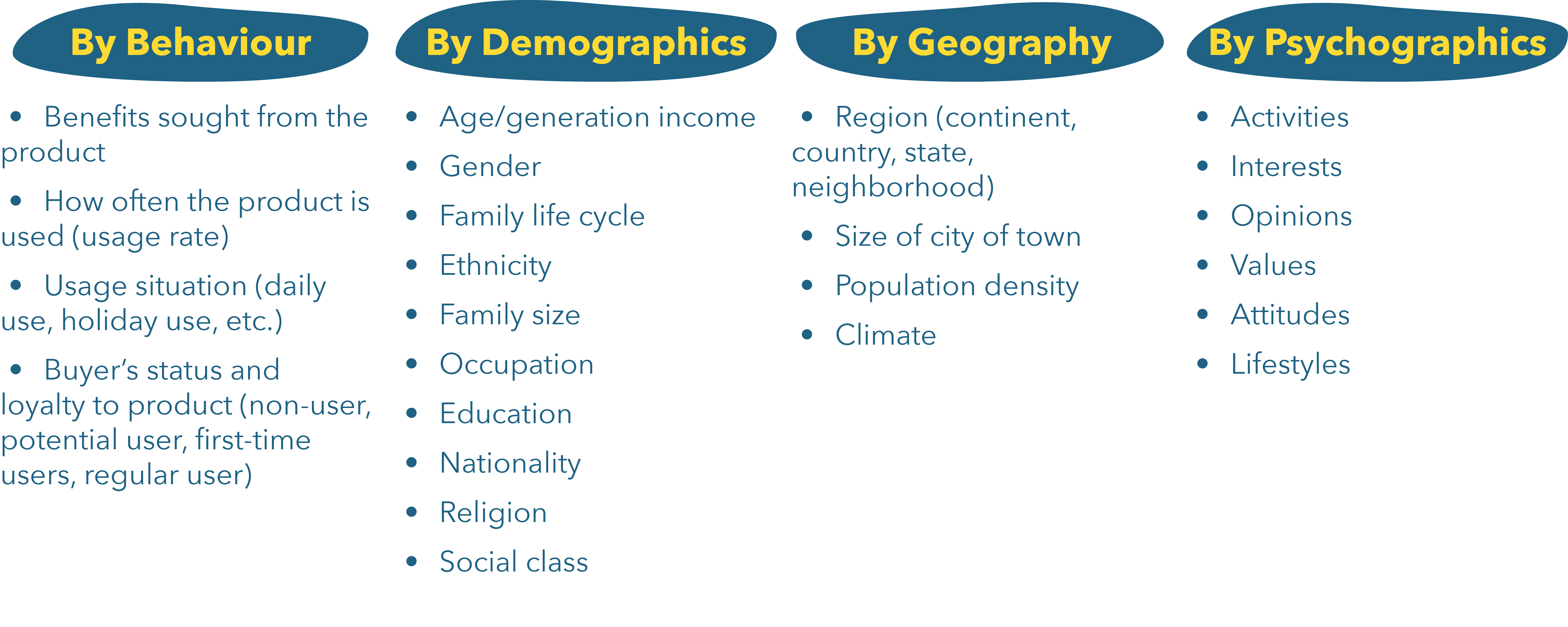
From University of Minnesota ‘Principles of Marketing’
Segmenting based on these variables are highly useful to inform online targeting strategies. For example, on the Facebook Ads platform, you can easily select to deliver an ad to people aged between 18 to 25 years old living within a kilometer of the Mile End who like cycling.
Yet, this provides less information as to how to talk to these consumers. For this reason, we emphasize the importance of intersecting segments with their goals, wants, needs and motivators, and the challenges they face. This provide key information to create your digital marketing campaigns.
In her Introduction to Consumer Behaviour, Andrea Niosi explains these as follows:
A goal is the cognitive representation of a desired state, or, in other words, our mental idea of how we’d like things to turn out (Fishbach & Ferguson 2007; Kruglanski, 1996). This desired end state of a goal can be clearly defined (e.g., stepping on the surface of Mars), or it can be more abstract and represent a state that is never fully completed (e.g., eating healthy). Underlying all of these goals, though, is motivation, or the psychological driving force that enables action in the pursuit of that goal (Lewin, 1935).
Motivation can stem from two places. First, it can come from the benefits associated with the process of pursuing a goal (intrinsic motivation). For example, you might be driven by the desire to have a fulfilling experience while working on your Mars mission. Second, motivation can also come from the benefits associated with achieving a goal (extrinsic motivation), such as the fame and fortune that come with being the first person on Mars (Deci & Ryan, 1985). One easy way to consider intrinsic and extrinsic motivation is through the eyes of a student. Does the student work hard on assignments because the act of learning is pleasing (intrinsic motivation)? Or does the student work hard to get good grades, which will help land a good job (extrinsic motivation)?
Consumer behavior can be thought of as the combination of efforts and results related to the consumer’s need to solve problems. Consumer problem solving is triggered by the identification of some unmet need. A family consumes all of the milk in the house; or the tires on the family car wear out; or the bowling team is planning an end-of-the-season picnic: these present a consumer(s) with a problem which must be solved. Problems can be viewed in terms of two types of needs: physical (such as a need for food) or psychological (for example, the need to be accepted by others).
Although the difference is a subtle one, there is some benefit in distinguishing between needs and wants. A need is a basic deficiency given a particular essential item. You need food, water, air, security, and so forth. A want is placing certain personal criteria as to how that need must be fulfilled. Therefore, when we are hungry, we often have a specific food item in mind. Consequently, a teenager will lament to a frustrated parent that there is nothing to eat, standing in front of a full refrigerator.
Most of marketing is in the want-fulfilling business, not the need- fulfilling business. Apple does not want you to buy just any watch; they want you to want to buy an Apple Watch. Likewise, Ralph Lauren wants you to want Polo when you shop for clothes. On the other hand, a non-profit such as the American Cancer Association would like you to feel a need for a check-up and do not care about which doctor you go to. In the end, however, marketing is mostly interested in creating and satisfying wants. Often discussion around needs are further explained in the context of those which are utilitarian (practical and useful in nature) and hedonic (luxurious or desirable in nature).
To this list, we add the notion of challenges. By challenge, we refer to an obstacle faced by a consumer in wanting to resolve a need or fulfill a want. This is important because consumers turn to the Internet everyday to help them answer challenges they face in their everyday life, whether it is how to change a tire, how to have the perfect Friday night make up, or how to paint a room. Resolving challenges drive the consumption of online content.
Hence, when creating a persona, you create a semi-fictional representation of a segment by bringing together the following information:
- Basic behavioral, demographic, geographic, and psychographic information to facilitate targeting
- Needs, and/or wants, and/or goal, and/or challenges to facilitate the creation of your campaign
- Information that makes your persona ‘feel’ real, such as
- Picture
- Quote from interviews with real consumers
- A name
- Examples of ‘real’ problems
Take the following example of RV Betty:
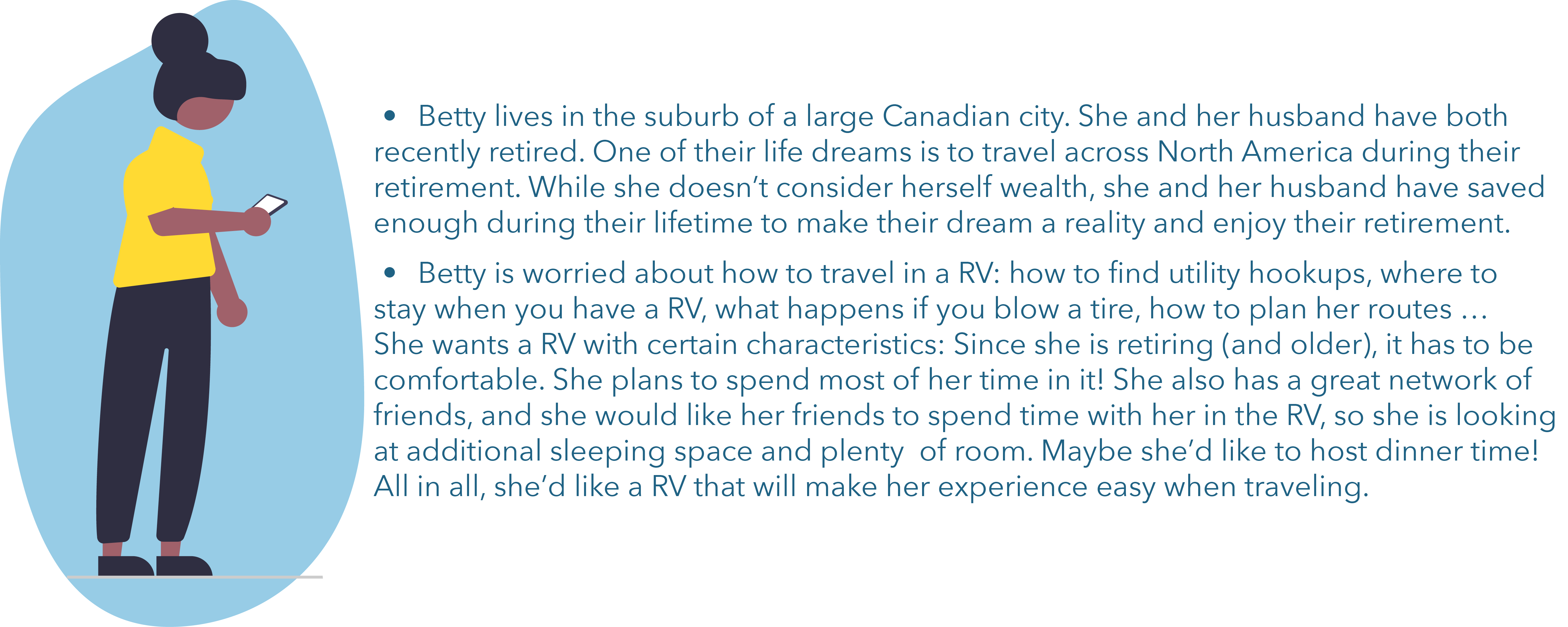
Can you find the information mentioned above in this short persona?
Rethinking the Consumer Journey
A consumer journey is the trajectory of experiences through which a consumer goes from not knowing they want something, to buying this something, to performing postpurchase activities (the most obvious being consuming the product). More theoretically put, it is “an iterative process through which the consumer begins to consider alternatives to satisfy a want or a need, evaluates and chooses among them, and then engages in consumption” (Hamilton et al. 2019). The journey is composed of pre-purchase activities, i.e., activities consumers take prior to buying a product; purchase activities, or what people do to acquire a product; and postpurchase activities, what happens once consumers have bought a product (Lemon and Verhoef 2016).
As a side note, we make a distinction in this course between customer journey, which would focus on the journey of a customer with a specific firm and would include, for example, touchpoint solely associated with that firm, and consumer journey, which is a broader perspective on consumers who “undertake [a journey] in pursuit of large and small life goals and in response to various opportunities, obstacles, and challenges” (Hamilton and Price 2019, p. 187). By touchpoint, I refer to “any way a consumer can interact with a business, whether it be person-to-person, through a website, an app or any form of communication” (Wikipedia).
Understanding the consumer journey is important because it strongly contributes to firm performance. For example, a survey by the Association of National Advertisers in 2015 found that top performers in a market understood the journey better than their peers, and had better processes to capture journey-related insights and use them in their marketing efforts (McKinsey 2015).
The journey varies greatly depending on which market a firm evolves in. It also varies depending on personas and their specific goals. For example, a survey by Google found that some markets, such as banking, voting, and finding a credit card, will have a typically longer journey than others, such as groceries or personal care products. And variation exists within markets. Google found, for example, three types of journeys for restaurants: one where consumers pick a restaurant within the hour; one where consumers pick a restaurant a day before; and a last one where consumers pick restaurants 2 to 3 months before.
Can you think of what these relate to?
We can hypothesize: If you’re at work and looking for a place to have lunch, chances are, you won’t dedicate much time to it and will pick a restaurant within the hour before going. If you are going out with friends or a Tinder date, you might be a bit more involved in the process and will pick the restaurant one or two days before. Lastly, if you are going to travel (and are a foodie!) or you want to make a marriage proposal, this will require more planning, and you might start your journey much, much before. This also has implications for restaurants! Some restaurants who cater to downtown lunchers might be better off pushing Instagram ads with the menu of the day, or some daily sale, around 11AM before lunch. Restaurants catering to groups or dates might want to start campaigns on Wednesdays to capture restaurants Friday and Saturday restaurant-goers. And restaurants that target the marriage proposal or foodie crowds might need longer, ‘always-on,’ continuous marketing activities to bring in patrons.
Understanding Consumer Journeys
Our understanding of consumer journeys has greatly evolved over the last two decades, and there exists a number of ways to conceptualize journeys. It is important to understand that these are not perfect representations of reality. Rather, they are thinking tools that help us create marketing campaigns. In real life, people tend not to be so linear in their decisions.
A common conceptualization found in marketing textbooks is one where consumers move between different stages, initially being aware of a large number of brands, and slowly refining their understanding of the options in the market to make their purchase. McKinsey represents such a typical model here. In this model, the consumer goes through 5 stages:
- Awareness: the consumer is aware of a large number of products or brands in the market that might help address their need
- Familiarity: From this large number of brands or products they are aware of, the consumer will make some initial research and become familiar with a subset of brands.
- Consideration: From this smaller number of familiar brands, the consumer will continue their research efforts, eliminate some brands that do not fit their criteria, and narrow to a smaller number of considered brands (i.e., a ‘consideration-set’).
- Purchase: Once ready to buy, the consumer might try out, or seek in-depth information on an even smaller subset, based on their consideration-set, from which they will purchase a product or a brand.
- Loyalty: Assuming their consumption experience goes well, the consumer can become loyal to the product or the brand.
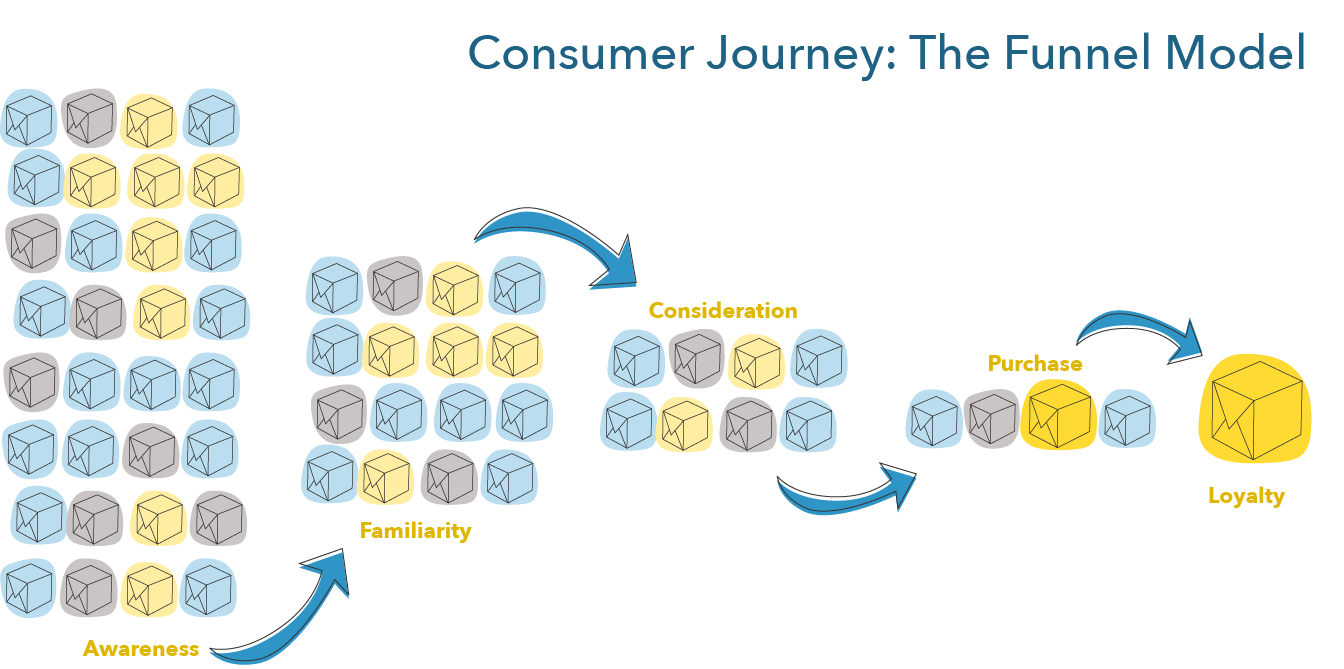
This understanding of the journey is based on a funnel model, where consumers start with being aware of a large number of brands, and over time, reduce their options as they go through each of the stages. This has a number of implications for marketers.
A first, central assumption is that, to be ultimately chosen by consumers, companies need to make sure that consumers are aware of them. This partly helps explain the prevalence of mass marketing: it serves to create awareness.
A second, central assumption is that consumers start with a large set of brands that are aware of, and over time, reduces this set to a smaller and smaller set of brands as they search and evaluate options.
McKinsey introduced in 2009 a competing model for the consumer journey, based on the purchase decisions of close to 20 000 consumers across five industries. They found that these two assumptions did not hold:
First, consumers do not start with a large set of brands they are aware of. Second, consumers do not reduce their options as they go through the stages of the funnel. Rather, the number of options they consider increase throughout their journey.
If you think of some recent purchases you made, this makes sense. Let’s say I want a pair of running shoes. I might be aware of some brands and model, probably the ones that do the most mass advertising: Nike, Adidas, Reebok. Then, I turn to the Internet to perform some searches. I’ll use general key terms like “What running shoes should a beginner get” or “Reviews for running shoes 2020.” Throughout my search efforts, I will encounter new brands I had not considered originally, for example, Asics, Brooks, and Saucony.
In this example, rather than following the funnel metaphor, where the set of brands I was aware of reduced to a smaller set of familiar brands and an even smaller set of considered brands, I added brands to my consideration-set.
This has important implications for digital marketers: First, traditional, push, mass marketing media activities are not necessary. Second, consumers broaden the set of products or brands they consider when they do research. We will see how this has led to the rapid growth of inbound marketing activities that help consumers with their problems and help consumers evaluate their options. This is because brands now understand that by supporting consumers throughout their journey, they can enter consumers’ consideration-set and ultimately make a sale.
McKinsey thus proposes a competing model, a circular model for the consumer journey. The model is circular because consumers enter a loyalty loop, where they move between using a product or brand, buying this product or brand again, participating in postpurchase activities, and so on. The McKinsey model has the following stages:

- Trigger: The consumer experiences a need, problem, or want to achieve a goal, which initiates their journey
- Initial consideration-set: The consumer considers an initial set of brands, based on their experiences, brand perceptions, and exposure to recent touch points. For the initial consideration-set, the most influential touchpoint is company-driven marketing, such as advertising, direct marketing, sponsorship, and the likes. See a graphic representation here.
- Active-evaluation: This is a new stage introduced by McKinsey. At this stage, the consumer actively evaluates their options through information gathering and shopping. Often, consumers will do information gathering online. It is at this stage that consumers add brands to their consideration-set. We are not in a funnel model anymore. This is a first difference of importance for digital marketers: It means we can enter consumers’ consideration-set without having to do awareness-generating campaigns. If we help consumers make their decision, or if we have reviews online, for example, we can be considered by them. McKinsey finds that the most influential touchpoint for this stage is consumer-driven marketing, such as word-of-mouth, the information found during online searches, and reviews.
- Moment of purchase: The consumer selects a brand, which they purchase.
- Postpurchase experience: After purchasing a product or a service, the consumer builds expectations based on their experience. This will inform the loyalty loop. A second important difference with the funnel journey happens at this stage: Consumers start creating content for brands (i.e., the ‘consumer-driven marketing’ efforts I refer to at stage ‘3’). Think about products or services you bought recently: Maybe you posted a picture about it on Instagram, maybe you wrote a review on Yelp!, or maybe you participated in some company-supported marketing activities.
These two important revisions to the journey—the expansion of the consideration-set during active-evaluation and the importance of consumers in participating in consumer-driven marketing at the postpurchase stage—open up many content-based possibilities for digital marketers. As we remember, our goal in digital marketing is to represent the customer: What are their needs? Goals? Problems? How can we support them in addressing these? Our objectives are not to sell products or talk about our brand. Rather, we will see that we make sales online by supporting consumers throughout their journey—helping them understand their problem, helping them evaluate solutions, helping them better understand our product.
Zero-Moment of Truth (ZMOT)
In a great content marketing for themselves (i.e., this concept helps sell Google products!), Google introduced in 2011 the concept of zero-moment of truth, “a new decision-making moment that takes place a hundred million times a day on mobile phones, laptops, and wired devices of all kinds … that moment when you grab your laptop, mobile phone or some other wired device and start learning about a product or service (or potential boyfriend) you’re thinking about trying or buying.” Yet, it is quite a useful concept to think about how consumers make purchases in the digital era.
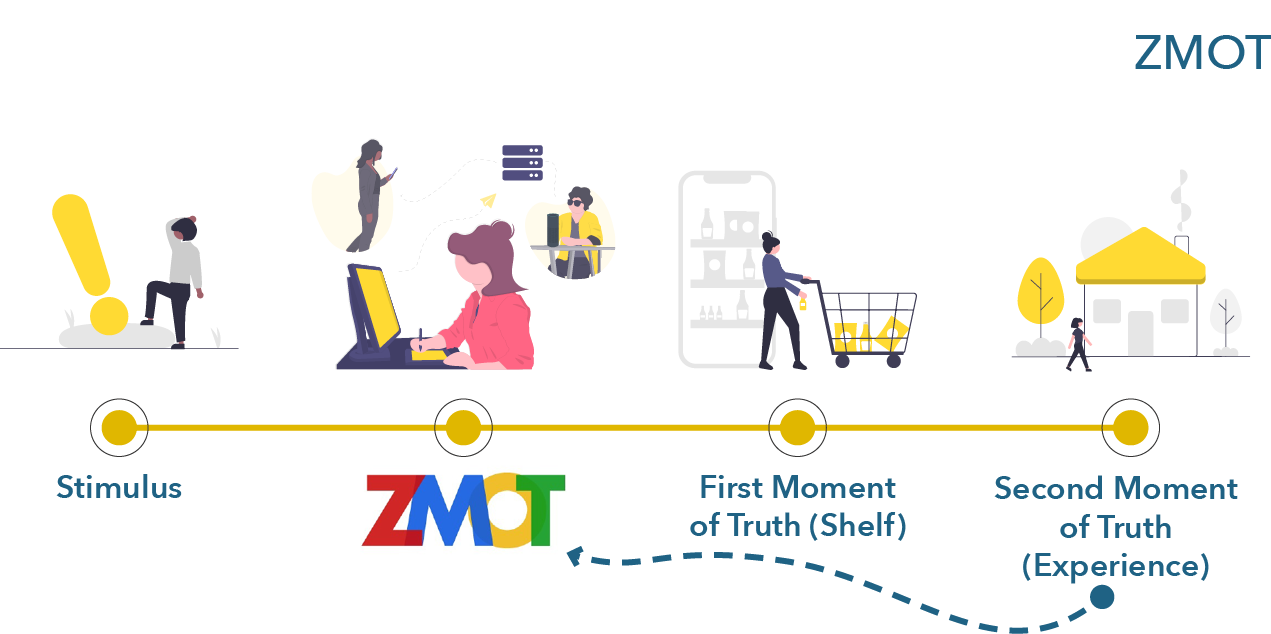
A moment of truth is a contact with a brand or a product when a consumer forms an impression (Carlzon 1989). To understand the ZMOT, it is important to contextualize it historically. Why is it called the ‘Zero’ moment of truth? Quite simply, prior to Google introducing his concept, there exists already two moments of truth:
- First moment of truth (FMOT): When a shopper notices a product in a shopping environment which influences their buying decision
- Second moment of truth (SMOT): When a consumer experiences a product following their purchase decision
The ZMOT is the moment of truth—the context between a consumer and a brand—that happens prior to a shopper notices a product in a shopping environment. Concretely, ZMOT ‘moments’ could appear during
- Online searches, talking with family and friends, comparison shopping, seeking information from a brand, reading product reviews, reading comments online, or starting to follow a brand
In contrast, the first moments of truth happen during
- Looking at a product on a shelf, reading a brochure at the store, talking to a salesperson, looking at a store display, talking with a customer service representative, using a sample in-store.
According to Google, characteristics of ZMOT are that: they happen online, when the consumer is in charge (and this relates to inbound marketing), during multi-way conversations. To capitalize on ZMOTs, Google recommends to be present in moments that matters. By this, the marketing juggernaut means that you should have content and ads that respond to the needs, problems, and goals that consumers are typing in the form of search queries on search engine. All of this requires, you might now have guessed, a deep understanding of your consumers and their journey.
Google identified four ZMOTs, and briefly explain how it interacts with journeys here:
- I want to know moments, where consumers turn to a search engine for a knowledge-based query
- I want to go moments, when consumers turn to search to go somewhere (e.g., “restaurant near me”)
- I want to do moments, when consumers want help to achieve something (Fun fact! For a while there, the most search ‘how-to’ video was ‘how-to kiss.’ Now, isn’t that sweet!)
- I want to buy moments, when consumers turn to search to help them make a purchase

These are important conceptual tools. They represent opportunities for companies online to create content. These are not simply ways to understand how consumers use search engines and interact online. Rather, they are tools to help us create better content. What kind of content would you create for these four different ZMOTs?
Journey Mapping
Now that we have identified the conceptual vocabulary, it is time to turn our attention to using this in practice. The journeys and ZMOTs are generic ways to understand how consumers go about buying products. Knowing how consumers conceptually move from a trigger to make a purchase to become loyal to a brand or product might be interesting in itself, but it is much more useful if we can actually use this in real-life campaigns. Effective strategies demand a tailored understanding. We cannot stay at a conceptual level. We need to translate them to real-life experiences. To do so, we can perform journey mapping.
A journey map is a visual representation of the journey of consumers. It brings together the conceptual tools we have seen in this chapter: persona, consumer journey, and moments of truth. They vary based on segments/personas. Each persona represents a different consumer segment. They should go about buying products differently. Think about, for example, how you and your parents go about buying products.
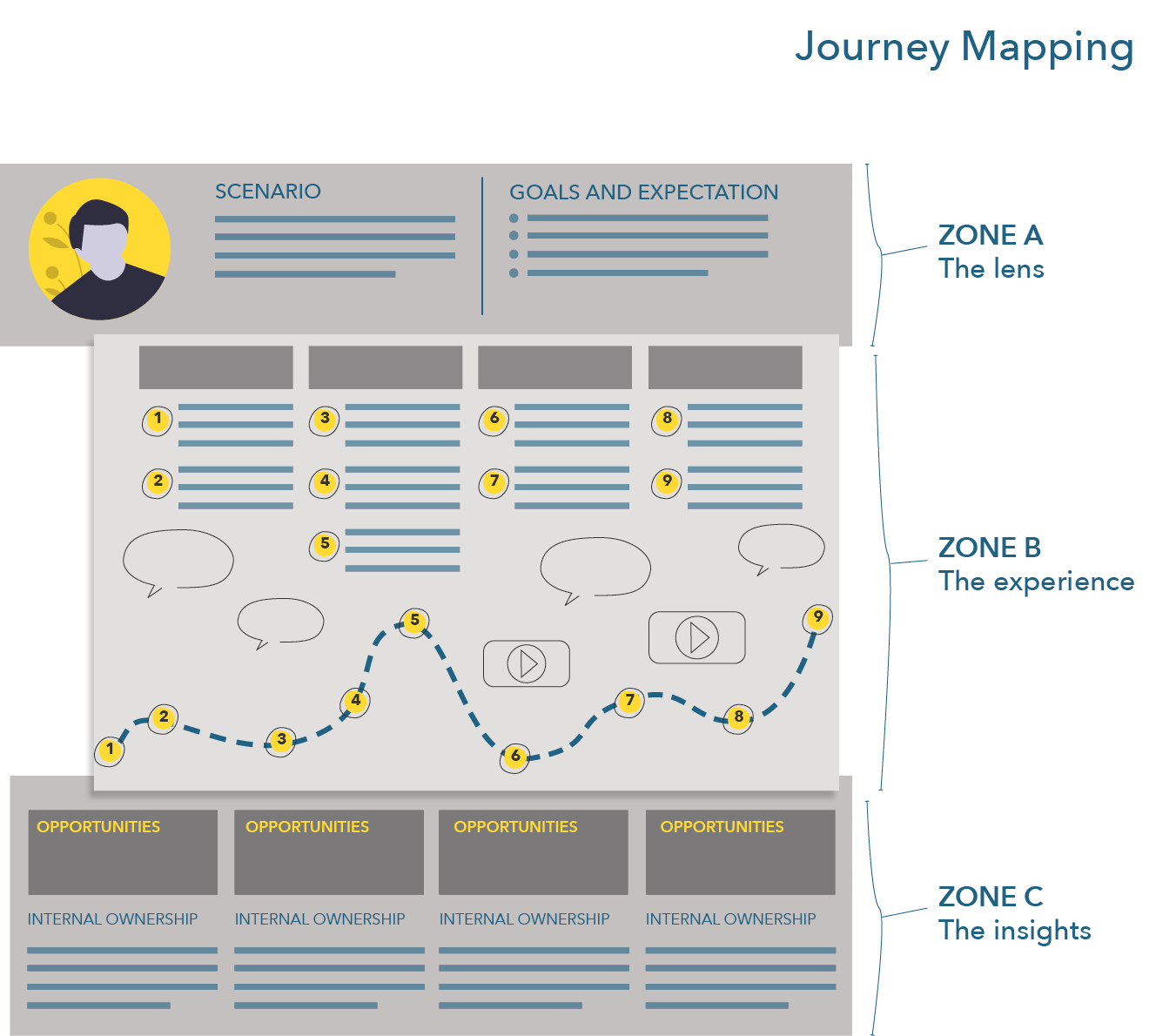
Journey maps exist in a wide range of shapes and forms. They do, though, share some comment elements:
- The persona
- Conceptual stages from a journey (e.g., Trigger, active-evaluation, purchase, postpurchase; or Awareness, consideration, purchase, loyalty)
- Concrete actions consumers take at each of these stages
- Touchpoints that they encounter (in this course, I strongly encourage you to include yours and that of others, i.e., this is a consumer journey, you should be thinking more broadly than only your firm)
- Opportunities associated with afore-mentioned actions
- This page presents a clear example of this kind of journey template
Journey maps are useful. They help you understand how consumers move through their journey to address their needs and problems. Each action they make represent an opportunity for your brand to create a connection with a consumer. A clear understand of the concrete steps that consumers take to buy products should be the starting point of the creation of your marketing campaigns. What do consumers do at the awareness stage? How can your brand support their actions? Do consumers search for specific things? What about at the active-evaluation stage? In the next chapter, we examine how firms can position websites on specific searches. This will help create a bridge between what consumers are doing online, and how we can answer their search queries.
Exercises
How to use a persona
Let’s take as an example the following persona ‘RV Betty:’

Betty lives in a suburb of a city. Her husband is also retired. They have been talking about traveling in an RV upon retirement for years – this is a long-time dream of theirs. The kids are self sufficient and have been out of the house for long enough that Betty doesn’t have to worry. She’s been retired just long enough to be bored. While she doesn’t consider herself as wealthy, she and her husband have a substantial savings and are prepared to enjoy their retirement.
Betty is worried about the logistics of travelling in an RV – how easy will it be to find utility hookups, where are the best places to stay if you have one, etc. She also wants something comfortable; she plans on spending a lot of time in it. She has other retired friends so she wants additional sleeping space and she wants to make sure they have plenty of room for food and even cooking. She wants as much ease as possible when traveling.
Based on this persona, briefly sketch 3 pieces of content. More precisely, concentrate on the general idea of what this piece of content would be about and draft:
- A first piece that addresses a problem or a need she is facing
- A second piece that helps her evaluate her options
- A last piece that sells your product
Tip: Make sure that your three pieces of content directly address the RV Betty persona!
Creating a persona
Sketch up a persona for a Montreal real estate company specializing in first-time house buyers. To do so:
- Identify a few socio-demographic characteristics (e.g., age, revenue)
- Find one general need or problem they are facing
Tip: Ask yourself why would these people need a house. For example:
- Why would people move to a house in Montreal?
- Are there different groups of first-time house buyers? What differentiate them? Which one are you concentrating on?
- Can you find one need or problem that unite that group?
Moving from persona to journey map
- Sketch a journey map for your real estate persona using the following journey stages
- Awareness
- Consideration
- Purchase
- Post-purchase
- Identify 2 concrete activities that your persona are doing for each stage
- Identify 2 touchpoints that your persona are entering in contact with for each stage
- Identify one opportunity for your company per activity

